Quick and Dirty Focaccia is named as such because it skips traditional focaccia-making steps but still delivers an incredible result – crispy crust, soft chewy crumb, and check out those glorious bubbles! The secret is a super high 93% hydration dough you just mix, rise, pour, and bake. This is even easier than the infamous No-Knead Crusty Artisan Bread….…never thought I’d top that, but here we are!
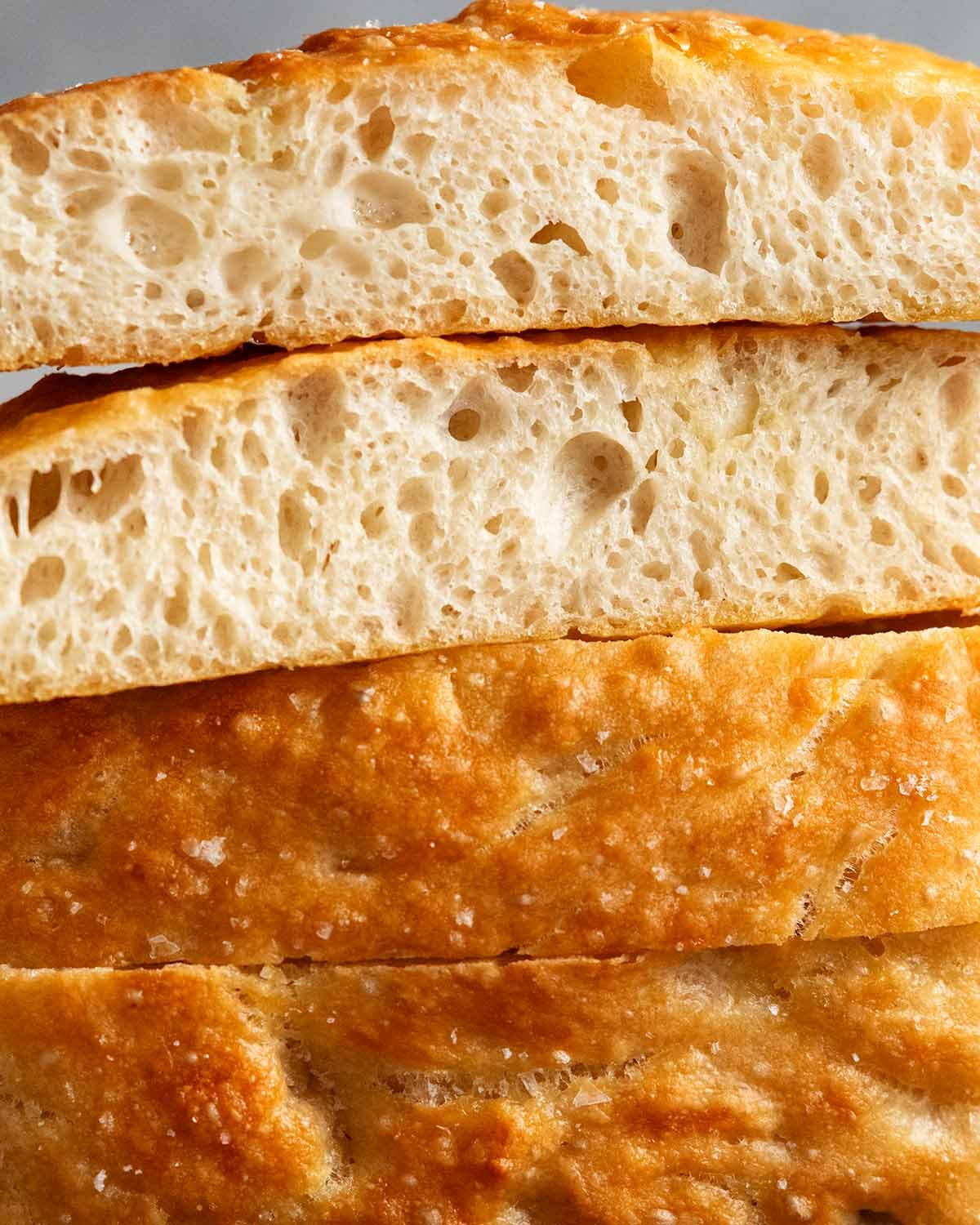

Quick and dirty focaccia is quick but not dirty!
There are many wonderful, scientifically perfect focaccia recipes out there, and millions of traditional Italian ones too.
This is not one of those.
And that’s why I’ve called it “Quick and Dirty” – because it skips so many steps traditional bread making steps. But there’s nothing dirty about it!
What it is though is an exceptional focaccia made with a fraction of the effort. In fact, I think this is the most hands-off bread recipe I’ve ever seen, and I mean that literally. You won’t touch the dough with your hands until it’s time to dimple. No kneading, no stretch-and-fold, no stand mixer. Just mix the dough in a bowl with a spatula, then pour it straight into the pan.
And yet …… the result is incredible! That signature olive-oily crispy crust, soft chewy interior, and glorious big bubbles.
Is it as good as traditional focaccia, made properly and painstakingly with 3 separate rises with fold-and-turns each time? No. Is it 93% as good with 30% of the effort? YES!
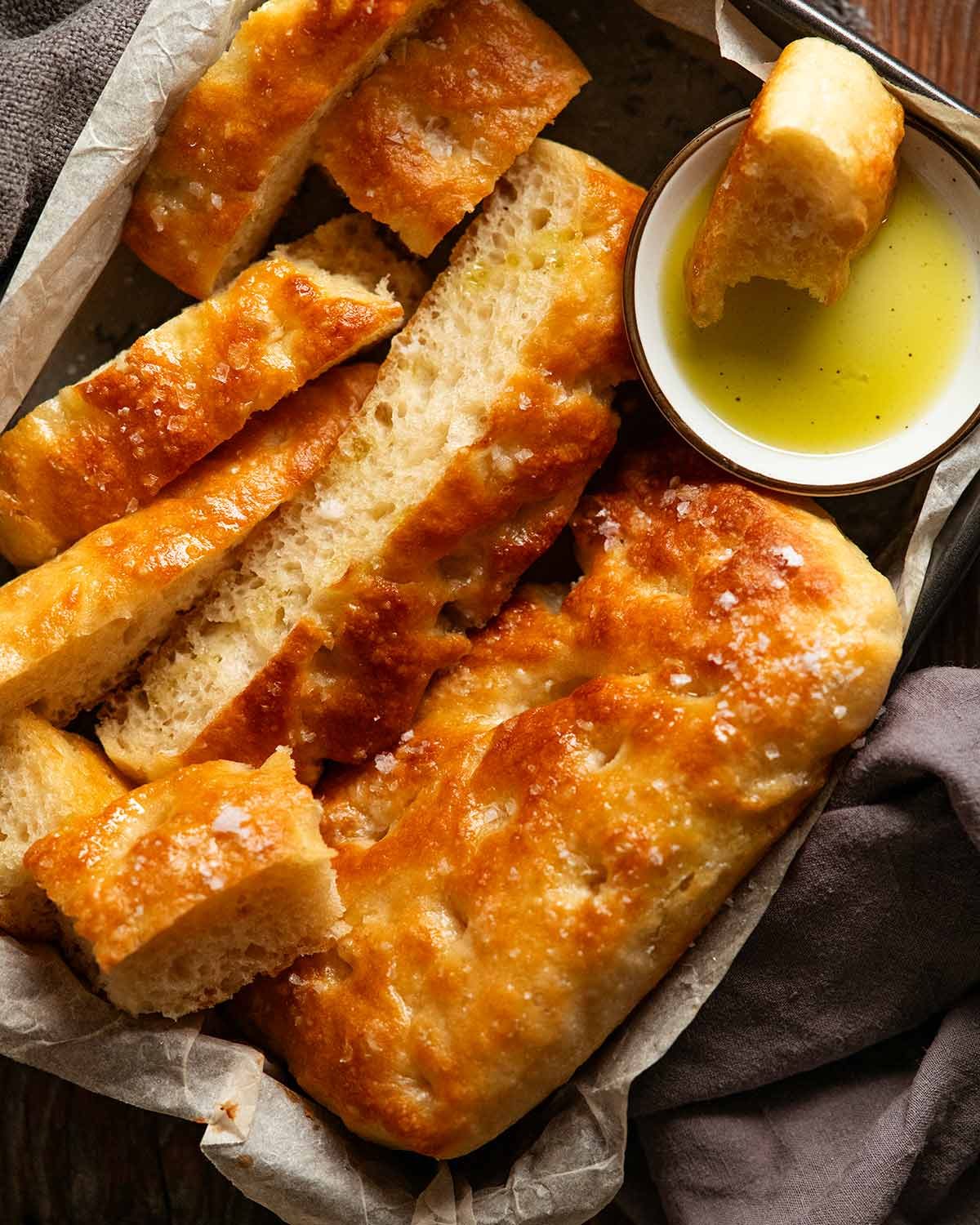
The secret: ultra high 93% hydration dough
The idea for this focaccia came from the very loose dough that is used in the infamous No-Knead Crusty Artisan Bread. The reason that recipe works so well is because of the high-hydration dough – 83%, to be exact, whereas typical bread recipes can be as low as 70%.
So I basically took that concept and pushed it even further for focaccia, thinking that because it’s baked in a pan which holds the dough in rather than shaped, I could make the dough even wetter which would make the crumb even softer and more moist, and the dough would prove faster because it’s so loose.
Incredibly, it worked, so much better than I expected!! Look at the dough, it’s so loose, it’s more like a batter:
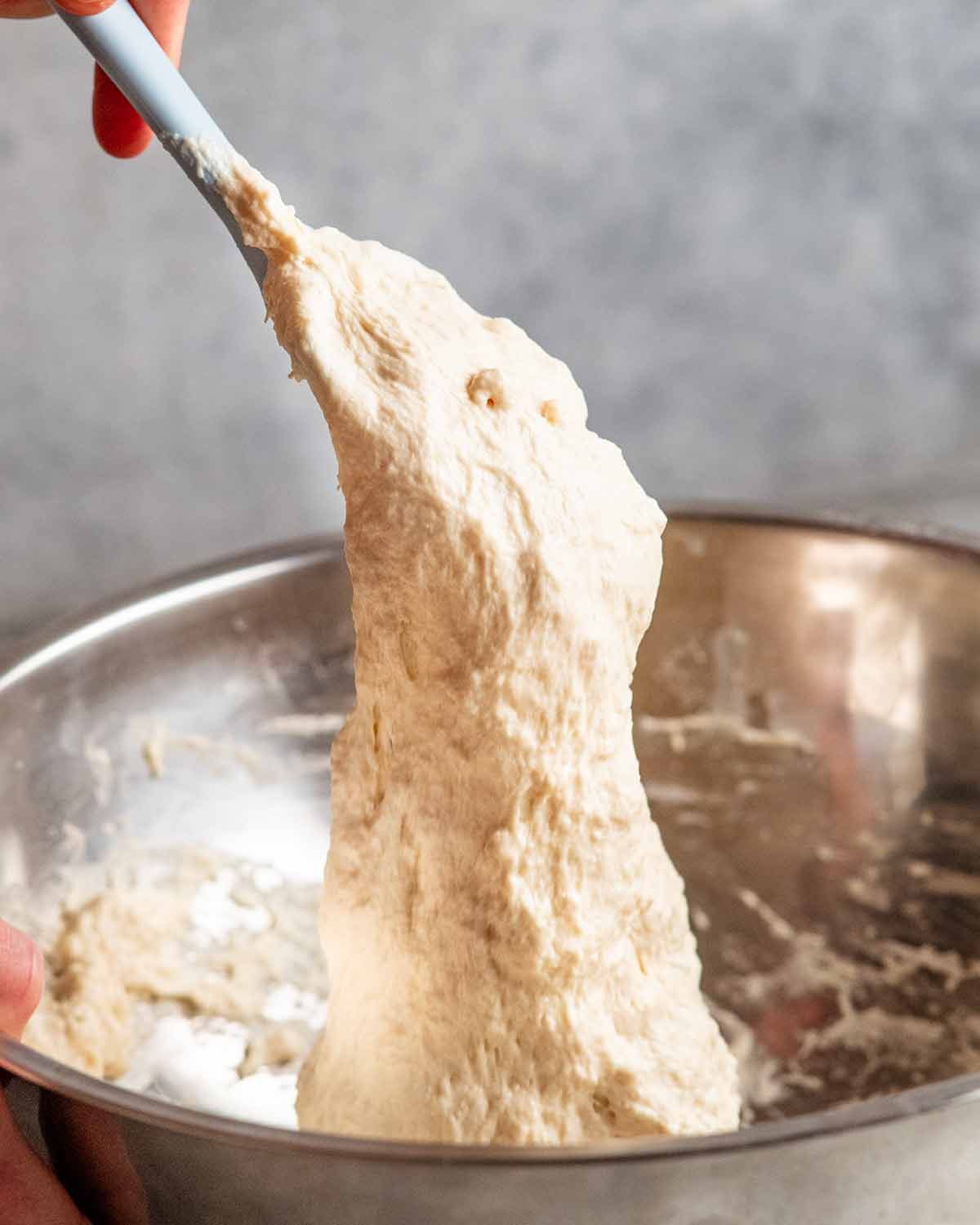
What you need for Quick and Dirty Focaccia
All you need to make this Quick and Dirty Focaccia is the usual yeast, flour, salt and water, plus olive oil for baking. It always amazes me how the same ingredients can produce such different breads by using different techniques!
No yeast? Use the batter in this Lunchbox Pizza bread instead, see FAQ below for directions.
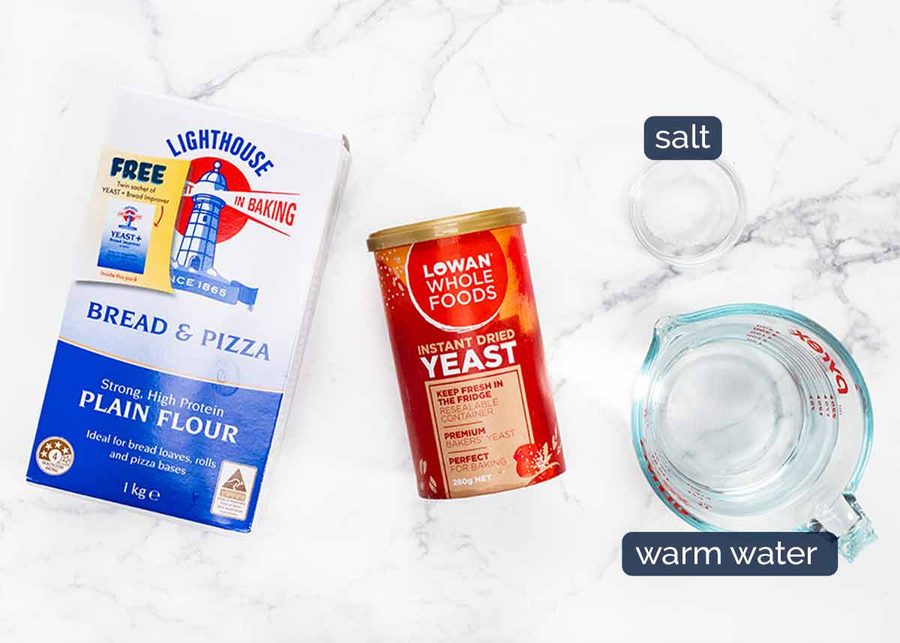
Instant yeast – Also called Rapid Rise Yeast, it goes straight into the dough – no need to dissolve and make it foamy first! Regular dry yeast (“Active Dry Yeast”) also works, you’ll just need to activate it in water first (see recipe notes). Both give the same result!
Tip: Store yeast in the fridge to keep it fresh.
Bread flour is best – It makes focaccia fluffier and chewier thanks to its higher protein (12%+), which creates more gluten. Look for packets labelled “bread flour” or “pizza flour”, or if not clear, look at the nutrition label to make sure it’s 12% protein (ie 12g or more per 100g).
Plain flour (all-purpose flour) is under 10% protein and works just fine – it’s not quite as chewy, the surface is a little more rustic, the crumb is a little less soft and will have fewer larger holes, but it’s still delicious and fluffy and I’d happily make it tonight. Here is one made with regular flour:
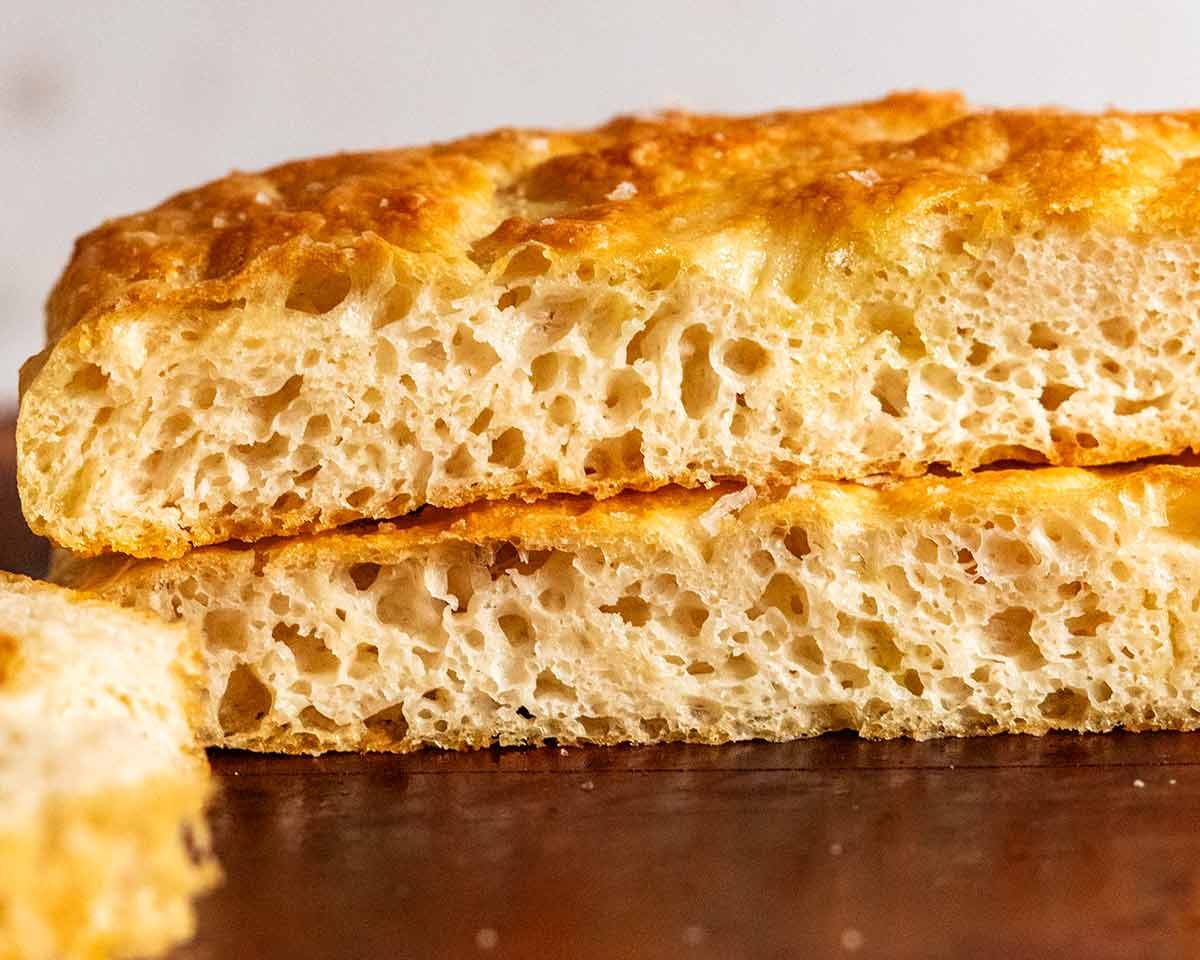
Salt x 2 types – I use regular cooking salt (kosher salt) in the dough and reserve the pricier sea salt flakes for on top, because I like that it’s still visible after baking and how you get lovely little pops of crunchy salt when you bite into it. I prefer using grains in the dough because it disperses and dissolves better.
Quite warm water – 38-45°C is a good temp (100–113°F). Think, comfortable bath, though if you want to be sure, use a thermometer or mix 1/3 cup boiling water and top up with cold tap water. 🙂
If the water is too hot, you will kill the yeast – it starts to die at 55°C / 130°F. If it’s too cold, the yeast takes longer to activate and rise the dough. Lucky yeast makes magical things, else we wouldn’t stand for the fussiness!
How to make Quick and Dirty Focaccia
This will knock your socks off with how ridiculously easy it is. I honestly didn’t think it would work -just another of my “what if…?” experiments I expected to fail (like most do!). I’ve made this 12 (15?) times since, and I’m still amazed! 😅

Make dough – Using a rubber spatula, mix the flour, salt and instant yeast in a large bowl. Make a well in the centre then pour the water in and mix until you can no longer see flour.
Sticky! – This is the consistency of the dough, it’s like a really thick muffin batter. It’s far too wet and sticky to be kneaded, but it should be thick enough to mound in the bowl (not spread like a soup). The unusually high hydration is why this recipe works so well, so please trust the process!
Adjustments – Aim for the dough consistency you see in the video, adjusting with more water or more flour as needed. Different flour brands and even the air humidity can affect water absorption. More chatter on this in the FAQ.

Rise 2 hours – Cover the bowl and leave it somewhere warm until doubled in size, about 2 hours. The dough will loosen, spread out, and look like a bubbly, jiggly soup.
Rising too fast? Move it somewhere cooler. Not rising? Find a warmer spot (see FAQ). Overnight fridge – see FAQ. Shorter rise works, but the crumb is less chewy and it doesn’t puff as much – I’ve tested a 1-hour rise and it’s still good, just not as good.
Don’t overproof! If it grows more than 1.5x, the yeast can run out of steam and the focaccia won’t rise as well in the oven.

Prepare pan – Lightly grease a 26.6 x 20 x 5cm (10.5 x 8 x 2″) or 22cm/9″ square metal pan with butter. Scrunch up a sheet of baking paper to wrinkle it up then un-scrunch and press into the pan. Make sure you have sufficient overhang so you can lift the focaccia out while hot (it’s fragile, so if you invert it flattens a bit – so I found 🙂 ).
💡Scrunched paper stays in the corners of pans, muffin holes etc better than flat. Pastry chef trick! And use butter rather than oil for greasing as the paper sticks better. Lastly, use metal rather than ceramic or glass, for a crispier base!
Pour – Drizzle some olive oil on the paper. Then use a rubber spatula to scrape the batter into the pan. ⚠️ Don’t mix the batter and deflate the bubbles before scraping into the pan!

Coax the batter into the corners using two spatulas, and make the surface as even as you can. There’s no need to be meticulous here, the dough will fill the pan during Rise #2, and the surface will smooth out too. PS Did you notice – clean hands! How good is that!

Rise #2 – Place a chopping board or heavy tray on top to prevent the surface from drying out, OR if your pan is not deep enough for sufficient head room to rise (my pan is 5cm/2″ deep), spray cling wrap with olive oil then loosely cover the pan.**
Then put the pan in a very warm place to let it rise for 45 minutes, or until it has risen by 50 – 70%.
** If the dough touches the board, when you remove it will tear the dough which makes it deflate so it won’t rise as much in the oven. If using a 20cm/8″ square or 23cm/9″ round pan, safest to use sprayed cling wrap.

LIGHT oil spreading! Drizzle olive oil across the surface of the focaccia. Tub some on your fingertips to prevent it sticking on the dough, then use your fingertips to lightly spread the oil across the surface without deflating the dough.
LIGHT dimpling! Then form your fingers into claw shapes and LIGHTLY press down only 1cm/0.4″ into the surface of the dough to make focaccia dimples. If you get too aggressive, like I encourage with traditional focaccia, you will deflate the dough!

Bake 25 minutes – Sprinkle the surface with salt flakes then bake for 25 minutes at 220°C/425°F (200°C fan-forced), rotating the pan at the 15 minute mark until the surface is deep golden and it’s crispy.

Cool 10 minutes – Lift the focaccia out of the pan using the paper overhang to transfer to a cooling rack, then slide the paper out from underneath. Cool 10 minutes before attacking!
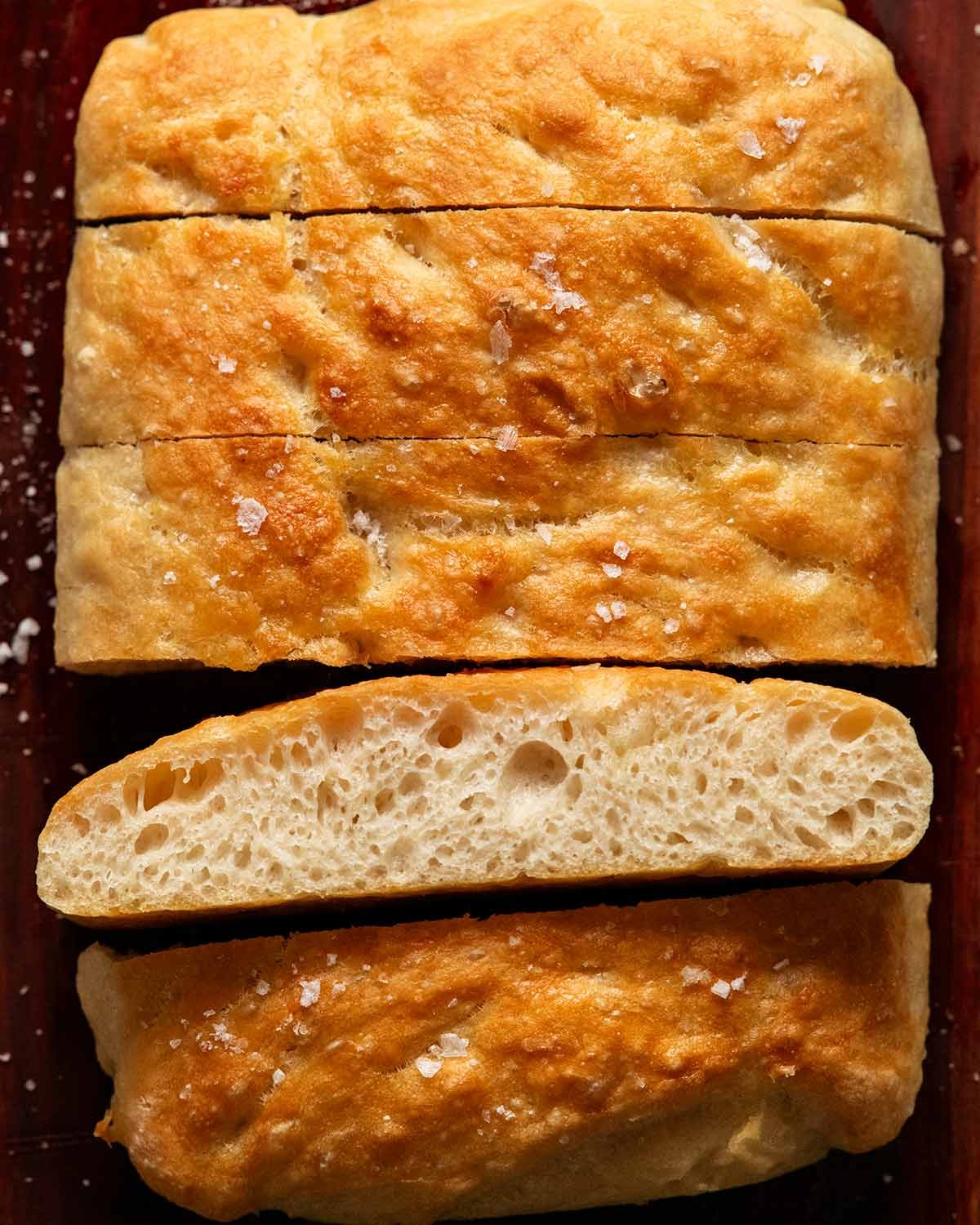
How I serve focaccia
Honestly, freshly baked focaccia is in a league of its own. The surface is crisp, it’s generously coated in olive oil, the inside is almost impossibly soft and tender and it’s well seasoned. It is one of the few breads in this world that you’ll happily eat plain, straight off the tray, without even a smidge of butter.
But actually, the traditional way to serve it is with extra virgin olive oil for dipping. This is the time to pull out your good stuff! The optional swirl of aged balsamic vinegar is also lovely (again, your good stuff!).
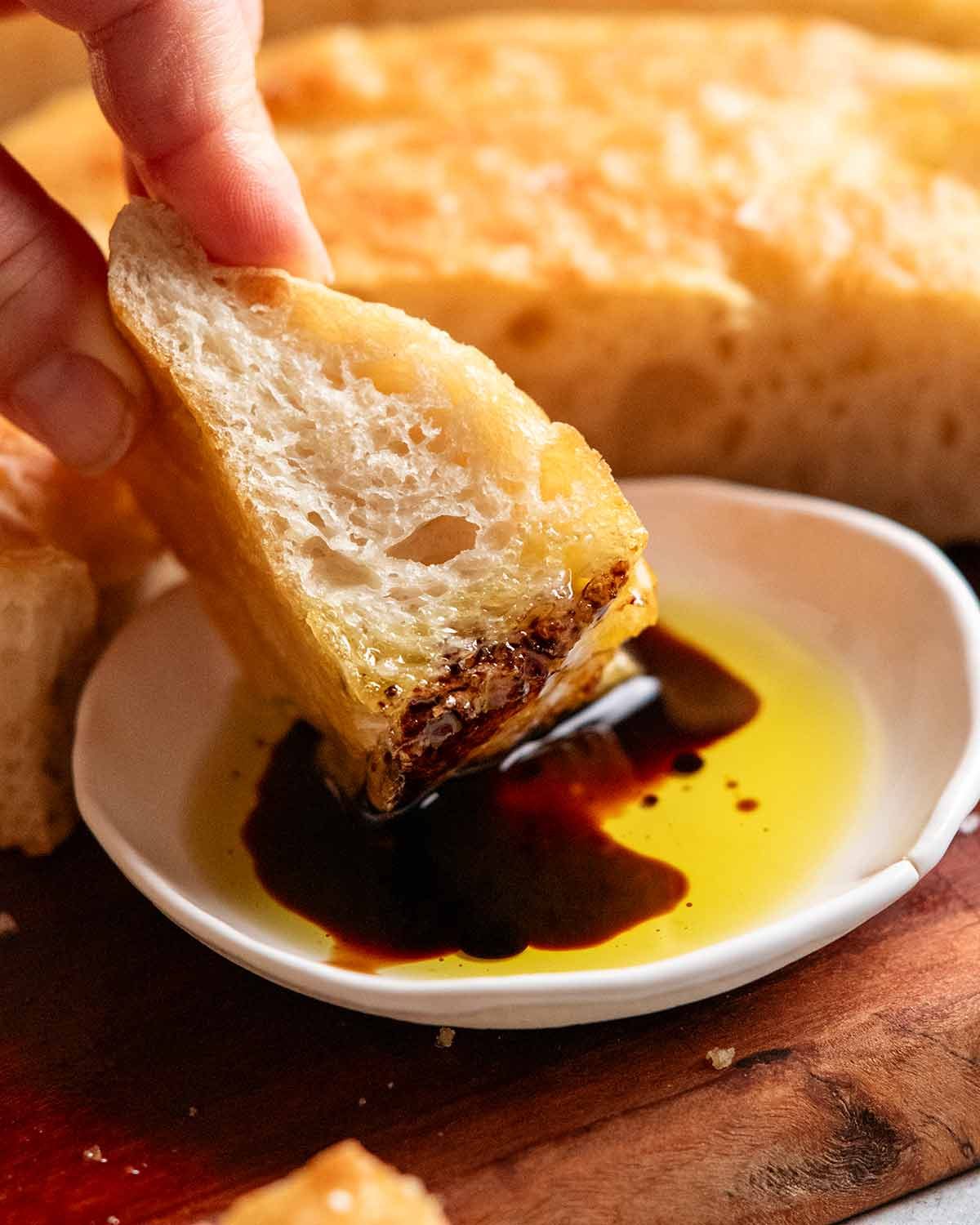
Serve it anytime of the day as a snack or nibbles with drinks, cut up into smaller pieces. For a bread basket, I cut it into larger pieces.
And of course, it makes brilliant sandwiches and toasties.
Everything you can do with bread, focaccia can do better! 🙂 – Nagi x
PS Moved the FAQ to below the recipe card, above Dozer, because it got a bit lengthy. Always lots of FAQ’s with yeast bread recipes! 🙂
Watch how to make it
Hungry for more? Subscribe to my newsletter and follow along on Facebook, Pinterest and Instagram for all of the latest updates.
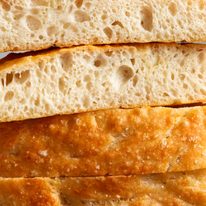
Quick and dirty focaccia
Ingredients
- 2 cups (300g) bread flour (or plain/all-purpose flour, Note 1)
- 1 1/8 tsp (3.5g) instant yeast (aka rapid rise yeast) (Note 2)
- 3/4 tsp (4.5g) cooking salt / kosher salt (-50% for table salt, + 50% for salt flakes)
- 1 cup + 2 tbsp (280 ml / 280g) very warm water (1/3 cup boiling water then top up with cold tap water) (Note 3)
Topping:
- 1 1/2 tbsp extra virgin olive oil
- 1/4 tsp (heaped) sea salt flakes (or regular salt, couple of pinches)
Instructions
ABBREVIATED:
- Mix dry, then mix in water. Rise 2 hrs to double. Drizzle EVOO into pan, pour into pan, rise 45 min by 50%. Oil surface, very lightly dimple, sprinkle with salt flakes, bake 25 min at 220°C / 425°F (200°C fan).
FULL RECIPE:
- Very sticky dough – Put the flour, yeast and salt in a bowl, mix to combine with a rubber spatula. Make a well in the centre, pour the warm water in then mix until you no longer see flour. It should be like a thick muffin batter – way too sticky and loose to knead.
- Rise #1 (2 hrs) – Cover with cling wrap then put in a very warm place to rise for 2 hours or until doubled in volume (Note 4), or do Rise #1 in the fridge 24 – 48 hrs (Note 5).
- Line pan – Use a 26.5 x 20 x 5cm (10.5 x 8 x 2") rectangle pan (metal, not glass or ceramic) or a 22cm/9″ square pan. Lightly grease with butter (not oil). Scrunch up a sheet of baking paper, un-scrunch then press into the pan, ensuring you have overhang to lift the focaccia out later. (Note 6)
- Dough in pan – Drizzle and spread 1/2 tablespoon of olive oil in the pan on the paper. Pour the dough batter in, then use 2 rubber spatulas to coax the dough out into the corners as best you can. Don't get too hung up on this, it will fill the pan as it rises.
- Rise #2 (45 min) – Cover with a cutting board (or similar – flat – but make sure there's enough space for the dough to rise!! Note 6), then put in a very warm place for 45 minutes or until it rises by 50 – 70% (you should see some nice big bubbling on the surface). Halfway through, preheat oven.
Bake!
- Preheat the oven to 220°C / 425°F (200°C fan-forced) with the oven rack in the middle.
- Drizzle 1 tbsp of olive oil across the surface. Rub a little oil on your fingertips then use your fingers to spread the oil lightly across the surface. (Note 6 for Toppings)
- LIGHT dimpling – Use your fingers to LIGHTLY press dimples into the surface of the dough, only pressing down about 1cm/0.4" into the dough, not all the way down like traditional focaccia else you will deflate the dough.
- Salt flakes – Sprinkle all over the surface.
- Bake for 25 minutes, rotating the pan at the 15 minute mark, until the surface is deep golden.
- Cool 10 minutes – Lift the focaccia out of the pan using the excess paper onto a cooling rack, then slide the paper out from underneath. Cool for 10 minutes then attack! Always best served warm.
Serving / cutting:
- Bread basket – I cut into 4cm / 1.5" wide strips then each into 2 pieces. Appetiser or to nibble on with drinks – I cut them into smaller pieces (generous) 2-bite pieces. In every scenario, it's accompanied with a good extra virgin olive oil for dipping, sometimes with a swirl of aged balsamic vinegar. Also makes excellent cheese toasties and sandwiches!
Recipe Notes:
Quick and dirty focaccia FAQ
Traditional focaccia is a stiffer dough with a kneadable texture, though actually it isn’t kneaded in the traditional sense. Rather, it uses a stretch-and-fold-rotate-and-repeat technique which is a form of kneading.
The crumb has a little more structure and chew because the gluten is worked more, and the crust is thinner than with this Quick and Dirty version.
But honestly? I describe this Quick and Dirty one as 93% as good, and for the enormous difference in effort, I know I’ll be making this one more frequently!
I’m sorry, I haven’t tried this with gluten free flour. Almond flour will not work unfortunately!
Leftovers will keep for 3 to 4 days in an airtight container though I really recommend reheating to rejuvenate. 180C/350F for 5 minutes is all it takes! It can also be frozen for 3 months.
Yes you can! Sliced veg (zucchini and potato come to mind!), olives, cherry tomatoes, pesto. See recipe card notes for when and how to add.
Breads made without yeast lack the chew, so they have more of a muffin-type texture. But I have made a yeast-free bread with focaccia vibes using this Lunchbox Pizza Bread. Skip the pizza toppings, use a teaspoon to make “dimples” on the surface, drizzle generally with oil, salt flakes, then bake per that recipe. 🙂
Yes you can, see recipe card notes for directions. It works the same but there’s an extra step to bubble the yeast.
Yes you can. To do this, after you mix the batter, cover with cling wrap at put it in the fridge for 24 to 48 hours. The dough will do Rise #1 in the fridge and will naturally stop once it doubles in size, so you don’t need to worry about over-proving. The cold fridge temperature essentially slows down the dough rise that happens in 2 hours in a warm place. You might be able to get away with 18 hours (ie it might double in that time), but it’s a bit risky – 24 hours is a sure thing.
Improvement in bread – Typically, rising dough overnight (whether it be pizza or almost any other type of bread) improves the bread in every aspect – taste, structure, crust etc. However, for this focaccia, I found the improvement was marginal at the 24 hour mark, but at 48 hours the crumb improved noticeably – better flavour, it rose more, the bubbles were larger – look at at the size of the bubbles in this 48 hours focaccia!

In summary, do an overnight / 24 hour rise for convenience but if you want noticeable improvement, do 48 hours!
When you take it out of the fridge, scrape into a pan per the recipe then expect to do Rise #2 for 30 minutes to 1 hour longer as the chilled dough needs to come to room temperature before it starts to rise.
Do whatever you need to find somewhere warm and cosy for the yeast to work its magic! Here are methods I use:
Near heaters
Dryer (this trick is a fave) – run the dryer for a few minutes to heat it up then put the bowl inside. Works so well!
Hot water dispenser box located under the sink. It generates heat, so why not use it!
On the counter in front of the oven (because it blows out warm air)
Summer – Easy, anywhere near warm sun coming into the house (but not in direct sunlight which is too strong)
Hot water bottles arranged around the bowl (not directly touching too hot)
Hand towels soaked in hot water, squeezed dry, then arrange around the bowl (repeat as they cool)
I have used the steamer ovens that have dough rising functions but I haven’t mastered this yet, the dough keeps rising too quickly. I think it is too strong.
It’s ok! No need to freak out, it’s easy to fix. Just add more warm water or flour and match my dough consistency in the video.
Even if you measured accurately using scales, different flour brands and even the air humidity can affect water absorption. On very, humid summer days, sometimes I add a smidge more flour to my doughs because they’re too loose. On frigid cold winter days the dough cools so fast it it becomes stiffer and dryer, so seems to need a smidge more water.
Use 1 tablespoon at a time to adjust and mix it through with the spatula until incorporated, then continue with the recipe as written. This dough is forgiving, it’s totally fine to tweak and adjust as needed.
2 hours is the goal minimum rising time, so if it’s rising too fast (eg you put it too close to the heater 🙋🏻♀️) move it further away to slow it down. If it’s too slow, find a warmer place (see above for practical suggestions).
A longer rise time works fine. Usually for breads, the longer you leave dough to prove, the better the flavour (eg overnight in the fridge). For this recipe, I didn’t notice much difference, so do overnight in the fridge for convenience rather than improvement (see Overnight Fridge FAQ below).
Yes, the focaccia recipe works with shorter rise times but the shorter the time, the less chewy the crumb and the less the focaccia rises. I’ve done a 1 hour rise and the difference is noticeable, though the focaccia was still very respectable.
If it’s a real emergency, you can speed up the rising time by putting the bowl in a very warm place. Steamer ovens often have dough rising functions which can be insanely fast for dough proving.
As with rise #1, it’s better not to do it much faster as it the focaccia rises better in the oven. As with Rise #1, I tried it faster (I put it under an electric blanket!) and it only took 20 minutes to rise by 50%. But the crumb was noticeably less fluffy than when I let the dough rise for 45 minutes.
As with Rise #1, if it is rising too fast, just move it to a cooler place to slow it down or stop the rising completely, but don’t put it in the oven before the 45 minutes has elapsed!
With either Rise #1 or Rise #2, if you leave it too long and it rises too much, it won’t rise as well in the oven.
Think of it this way – yeast only has a certain amount of rising power. If it uses it all up during the proving stage, there is not enough left for the baking stage!
The first time I made this was Sunday last weekend, just 5 days ago. I think we’ve made it 15 times since! I was inspired by a noticeable increase in focaccia in my social media feeds – it seems to be all the rage these days. I kept meaning to make my traditional focaccia but lacked the capacity to give it the attention it needed to make it. It’s not hard, but it’s considerably more hands-on than this recipe.
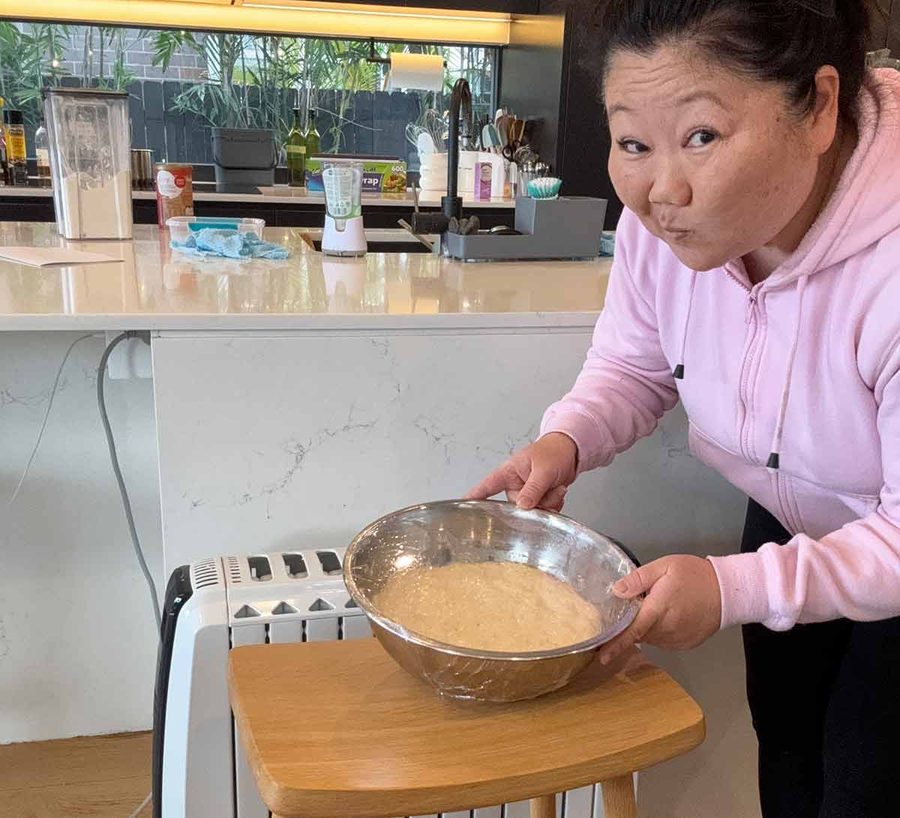
So anyway, I wondered whether I could make a lower effort focaccia using the very hands off bread making method I use for the No Knead Crusty Artisan Bread. That bread has a chewier, firmer crumb – think, sourdough – and thicker crust.
I wondered if I increased the hydration to make the dough even wetter and looser, I could make it more like focaccia – especially with the help of olive oil to make the crust nice and crispy.
Amazingly, even the first attempt came out exceptionally well.
From there, I had the base recipe and it came down to tweaking the base dough recipe. I increased the yeast by just 1/8 tsp and felt the bread tasted yeasty. Because I added salt flakes on the surface, I reduced the salt in the crumb so it wasn’t overly salty. I tried pushing the hydration to over 100%, but found the focaccia didn’t form enough of a crust and didn’t rise enough. 93% hydration is where it maxed out!
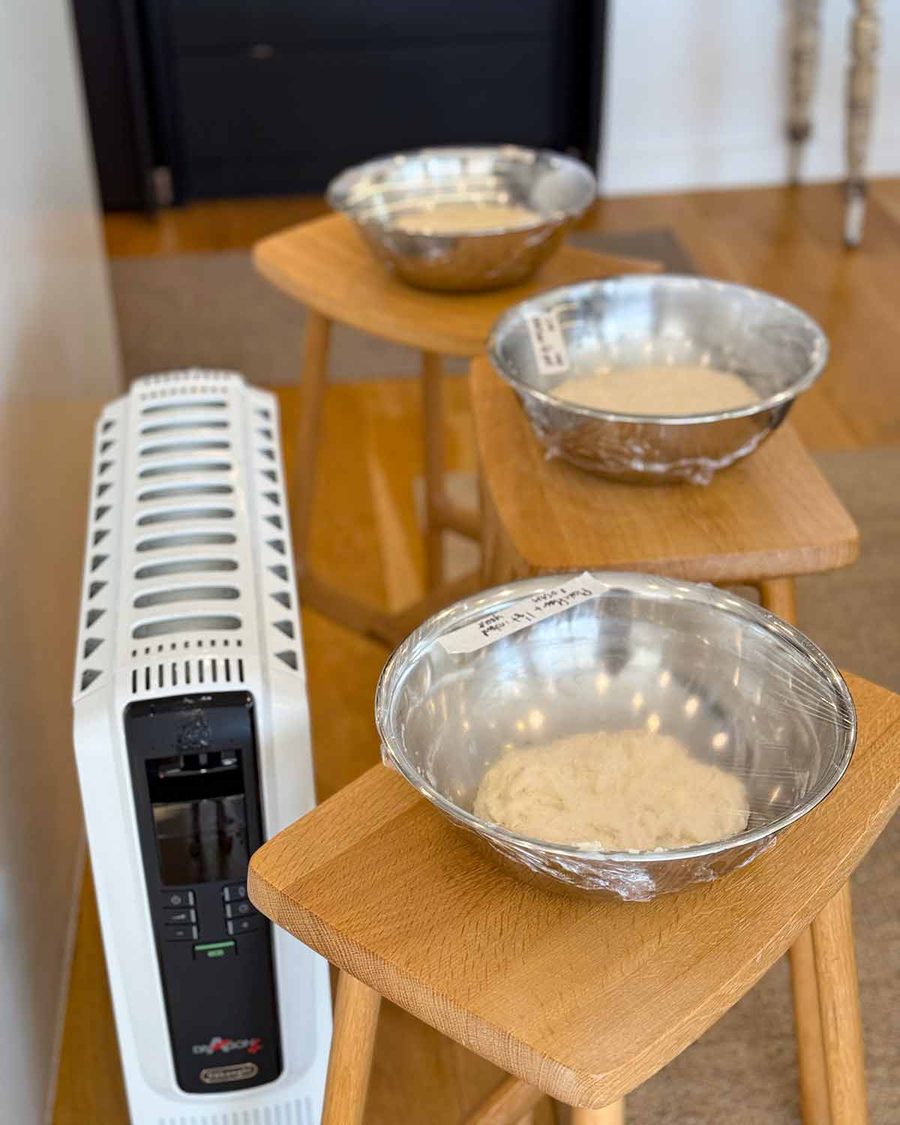
Then I played around with the dimpling technique. I tried doing the full aggressive jiggly-focaccia dimpling and it just made the dough collapse. I tried no dimpling at all, and bizarrely it didn’t rise as well – not sure why, thinking maybe dimpling loosens the skin and allows the bread to rise more?
In the end, I found that a light dimpling worked best. And the last thing we were testing was the best oven temperature for crispy crust, good colour and soft fluffy insides – increasing the temperature towards the end versus staying high the whole time vs baking at a regular temperature the whole time.
This recipe was largely driven by me, then JB and I worked together to do the numerous versions we tested before publishing it.

One of the things about working with a formally trained chef is that he has very refined palette, more refined than me. So he notices details better than me, like the improvement (or not) in the structure of a bread when, say, yeast is tweaked by just 1/8 teaspoon, and whether this focaccia is improved by overnight rising (barely noticeable). To me, it means I can publish recipes with even more confidence – no second guessing!
And just generally, it’s so great having a professional to bounce ideas off. It was JB who, after many versions where I stepped up the oven temp midway through baking, calmly suggested just baking at a slightly higher temp for the whole time.
Not only was it one step less, but it actually made the focaccia rise even taller with a better crust. 😂 I don’t miss the days of working alone with just Dozer – working with a team is the best!
Life of Dozer
Dozer is taking some cookies into SASH later today as a thank you for taking such good care of him during his dental procedure last Friday.

SASH had to take extra precautions for his general anaesthetic because of the tie-back in his throat and also because a higher risk patient due to his age and medical condition. SASH specifically arranged for the dental to take place when his tie-back surgeon was available so he could take the opportunity to look inside his throat and make sure everything was ok, and nobody gave me grief or judged me for camping out in reception the whole time he was there! 🙂
These adorable custom cookies are made by Claudia from Monogram Cookies, a local cookie store who specialises in making custom cookies. How cute are they!!

Second time I made this bread, absolutely love it, so easy and super tasty! And those cookies look amazing, even Dozer thinks so!😆
I appreciate your note on the dimpling. most recipes say to dimple right down. I have
stopped even trying to dimple but your note clarifies all. thankyou for another good recipe !
Amazing recipe! So simple and so delicious!
I made one sprinkled with Rosemary and Sea Salt Flakes, it was fantastic to accompany dinner – or just dipped in olive and balsamic oil. I made a second and topped it with a light brushing of pizza sauce, rosemary, sea salt flakes and stuffed some pepperoni in it then drizzled with “Hot Honey” – my partner said it was the best bread he’s eaten and wants me to make it weekly!
Thank you for a simple, tasty recipe that is sure to impress!
Made focaccia for the first time as hubby doesn’t like it. Well, that’s changed! Better than store bought…..of course!
Thanks Nagi
First time making bread and I’m so proud of myself *pats on back*.
I had to use a ceramic pie dish which definitely does not give you a crispy base 🤦🏻♀️ But the taste!
I also disagree with not really going with Asian food, I dipped into laksa and it was the best!
Another recipe that is fabulous. Nagi does not disappoint. It‘s perfect for a BBQ. With some Mediterranean Salt on top it‘s absolutely delicious. We ate the whole bread straight away. Thx Nagi for another yummy recipe.
So easy and tasty!! I’ve made this almost every day for the lady couple of weeks 😆 I’ve done it in a muffin tray too which worked brilliantly. It did use quite a bit more oil but super tasty and easy to eat.
Garlic powder, parmesan, and flake salt topping is the favourite in our house and my toddler loves helping! Will try roast capsicum next. Hubby puts basil pesto on it before eating for extra flavour.
Very forgiving recipe and one I’ll be using for years to come 😊 thanks Nagi!
Just made this stunning recipe – blown away by how easy it is, for such an incredible result! Light, fluffy foccacia with an insane crispy crunchy crumb. Not having to knead the dough is incredible. Topped it with sliced black olives before baking, and added chopped fresh rosemary halfway through baking when I turned the pan. Making sandwiches with the bread tonight with pork belly, basil pesto, and burrata – can’t wait. Will be making this regularly from now on. Thank you Nagi for another banger!
This is the best homemade bread ever. Top hit with 6 year old grandson who loves eating it and making it. The rest of the family just eat it
Recipe tin eats and Dinner cookbook are my go to recipe source for 90% of my cooking.
Thank you
This is incredible.
I made a couple changes.
I scaled the recipe to 9 serves to fit a 9×13 sheet pan.
I accidentally doubled the yeast. I also did a quick 30minute first rise in my steam oven. As it was baking, I wasn’t convinced it was working well as it didn’t appear to rise as much as other focaccia recipes I’ve made, I’ve just cut it up after letting cool, the crust is crispy and inside chewy. I would say it’s the best darn focaccia I’ve ever made!
Made this today, was delicious except my bread didn’t have as many holes in it, lovely crisp crust and super soft inside but not as “holey”, any suggestions?
This recipe is fantastic! This was my first ever attempt at making Focaccia. I couldn’t believe how easy it was and how amazingly it turned out. Thank you for the accompanying video as it makes a difference to be able to see how it should look along the way! The whole lot got eaten in the evening and my hubby now stated this is the only bread he wants to eat! Thanks for making such great recipes
Hi Nagi. Can you use gf flour for this recipe? Many thanks.
I just made this and it’s incredible. Nani does state in her FAQ that she hasn’t tried.
But I have made 3 GF focaccias this week, using a recipe from ‘the loopy whisk’ she uses a blend of GF flours, but they must be different as mine turned out chocolate brown (I think I used a different millet flour) I then tried it just using a store blend GF plain flour which made it easier and it worked great. The top didn’t get as crispy as this one of Nagi’s ~ but it tasted really good and could not detect that it was GF at all.
BANGER! Made it, beautiful.
Easy peasy. Thank you.
As always, your recipes are amazing.
Much love to the furry beast!
❤️💚💛 🇨🇦
For a while there I had to put the breaks on cooking and sort some stuff out!
Stuff sorted and I’m back in the kitchen.
Decided to give this focaccia a whirl .
Well, what a show stopper an absolute doozie.
I followed the recipe to the ‘T’ for in Naggi we trust, always. And why? Because she is bloomin’ brilliant 🤩
This bread is brilliant, delicious and so easy (but we don’t have to tell anyone that bit do we?)
Thank you Nagi for plugging on and giving us hope, faith and joy in cooking 😘
I’ve just made this for a third time! I took it to a family garden party. And it just disappeared in a flash with lots of compliments! I am so pleased with this recipe! 🤩
I just made this and I’m obsessed!!
My boyfriend reckons it’s good too, but said if it had cheese and bacon in it, then it would be epic 😂
Wondering if this is possible? When would you add cheese and bacon? Don’t know if it would still rise well with add ons ( also don’t like the idea of cheese and bacon sitting in a warm environment for hours) but it days not to mix it after it’s risen
Maybe just cheese and bacon sprinkled on top, after rising but before baking?
I could not believe this simple recipe turned out so fantastic. I topped 3/4’s of it with my hubby’s homemade roasted cherry tomato relish (it has onions and peppers in it) shredded Parm, shredded Moz and pepperoni which I put on before the bake. I don’t think I’d add anything to the dough (except maybe Italian seasoning) but I like it plain. If I were putting bacon on top I’d fry up a few pieces and leave them half-way cooked. I’d cut up and put on top before baking. The bacon will finish cooking and get crispy during the bake. I think if you cooked the bacon completely before topping, it may burn a bit. You could also cook fully and sprinkle on during the last five minutes of bake. The possibilities are endless with this Nagi’s recipe. My hubby is going to like your boyfriend’s great idea!!
This will now forever be my foccacia recipe. So easy, light, fluffy and delicious.
Best and easiest focaccia I’ve ever made. Although my dough was even wetter than in the video, the end result was perfect – and took only 15 minutes in my benchtop oven. Thank you!
It was amazing! My husband and in laws loved it. Bread was so easy to make and for my first time making any kind of bread I would call it a huge success!